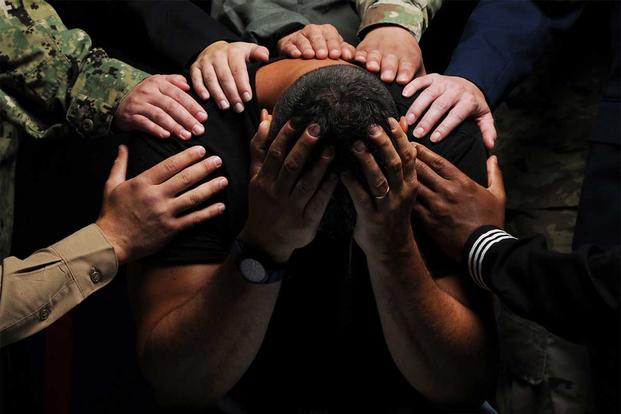The number of suicides and the suicide rate among U.S. veterans remained relatively flat in 2018 compared with the previous year – a stubbornly steady state that the Department of Veterans Affairs hopes to attack with new initiatives such as outreach to veterans not in the VA health system and counseling on safe storage of firearms.
According to VA’s National Suicide Prevention Annual Report, which focuses on suicides in the veteran population in 2018, the number of suicides and the suicide rate rose just slightly from the previous year, by 36 deaths -- 6,435 total suicides for an age- and gender-adjusted rate of 27.5 per 100,000 persons.
Read Next: Army, Guard Units Participating in Observer Mission that Sustained Tragic Helo Crash
In 2017, 6,399 veterans died by suicide, at an adjusted rate of 27.3 per 100,000. By comparison, the age-adjusted rate for all non-veteran U.S. adults was 18.2 per 100,000 in 2018.
The data in the VA report is two years old, and, like the national data on suicides published by the Centers of Disease Control and Prevention, does not reflect current conditions or ongoing efforts to stem suicide in the veteran and U.S. population.
The new data showing the uptick comes amid heavy VA investments in suicide prevention programs and outreach. In June, President Donald Trump announced the creation of a task force to address the issue of veterans suicide, known as PREVENTS, the President’s Roadmap to Empower Veterans and End a National Tragedy of Suicide.
VA officials have for years said that veterans who receive health services through the department have lower rates of suicide than vets outside the system, and the report contains evidence that initiatives within VA are helping: According to VA, the adjusted rate of suicide among patients who recently used VA health services dropped by 2.4%, while the rate among veterans who don’t get health care from VA increased by 2.5%.
For VA patients diagnosed with depression, the suicide rate has decreased since 2005, from 72.9 per 100,000 in 2005 to 66.4 per 100,000 in 2018. That’s despite a light uptick from 2017, when the rate was 65.1 per 100,000.
And the suicide rate for VA patients with anxiety decreased, from 83.1 per 100,000 in 2005 to 67 per 100,000 in 2018.
“The data shows the rate of suicide among veterans who recently used VA health services has decreased, an encouraging sign as the department continues its work and shares what we learn with those who care for and about veterans,” said Secretary Robert Wilkie in a release.
To Tom Porter, vice president of government relations at Iraq and Afghanistan Veterans of America, the data demonstrates that VA should continue trying to pull more veterans into the system and expand mental health services to vets through community partnerships.
“It shows we need to get as many veterans as possible into the VA,” Porter said. “We need to get them in and we need to get them in as quickly as we can.”
The report notes that in 2018, an average 17.6 veterans died by suicide each day, up from 17.5 per day in 2017. While this appears to be a sharp drop from the often-cited statistic of 20 per day, that measure included suicides among active-duty military personnel, Reserve and National Guard members.
The report’s release was delayed this year by more than a month – a lag VA officials attributed to wanting to include up-to-date figures on suicide and suicide attempts during the COVID-19 pandemic. Some Democratic lawmakers, however, said the timing of the release for after the election was a political move.
Sen. Jon Tester, D-Montana, the ranking member of the Senate Veterans Affairs Committee, pressed for release of the report and told Military.com Thursday that he was disappointed to see the numbers remain “alarmingly high.”
“I pushed VA to release its annual veteran suicide data report without delay because it is the principal source for tracking veteran deaths by suicide,” Tester said. “I remain particularly concerned about VA’s efforts to address the mental health needs of veterans during the COVID-19 pandemic. VA must … take a more aggressive, all-hands-on-deck approach towards connecting veterans with the mental health resources they need.”
Tester was a co-sponsor of the John Scott Hannon Veterans Mental Health Care Improvement Act, which increases staff for mental health services at VA and will provide grants to community organizations that provide mental health services to veterans.
President Trump signed the bill into law Oct. 18, and he is set to enact another piece of legislation, the Veterans Comprehensive Prevention, Access to Care and Treatment Act, or Veterans’ COMPACT Act, in the coming days.
That bill is designed to improve care for female veterans and those who have recently separated from military service and ease the costs of receiving emergency mental health services, among other initiatives.
The VA in 2018 and this year instituted several new initiatives it believes will have a significant impact on veterans suicide, including training and emphasis on safe storage and limiting access to firearms and other means for suicide. It’s also investing in improved risk screening and outreach to veterans not in the health system.
Patricia Kime can be reached at Patricia.Kime@Monster.com. Follow her on Twitter @patriciakime.
Related: Suicides, Attempts Among Veterans Drop During Pandemic, VA Says











